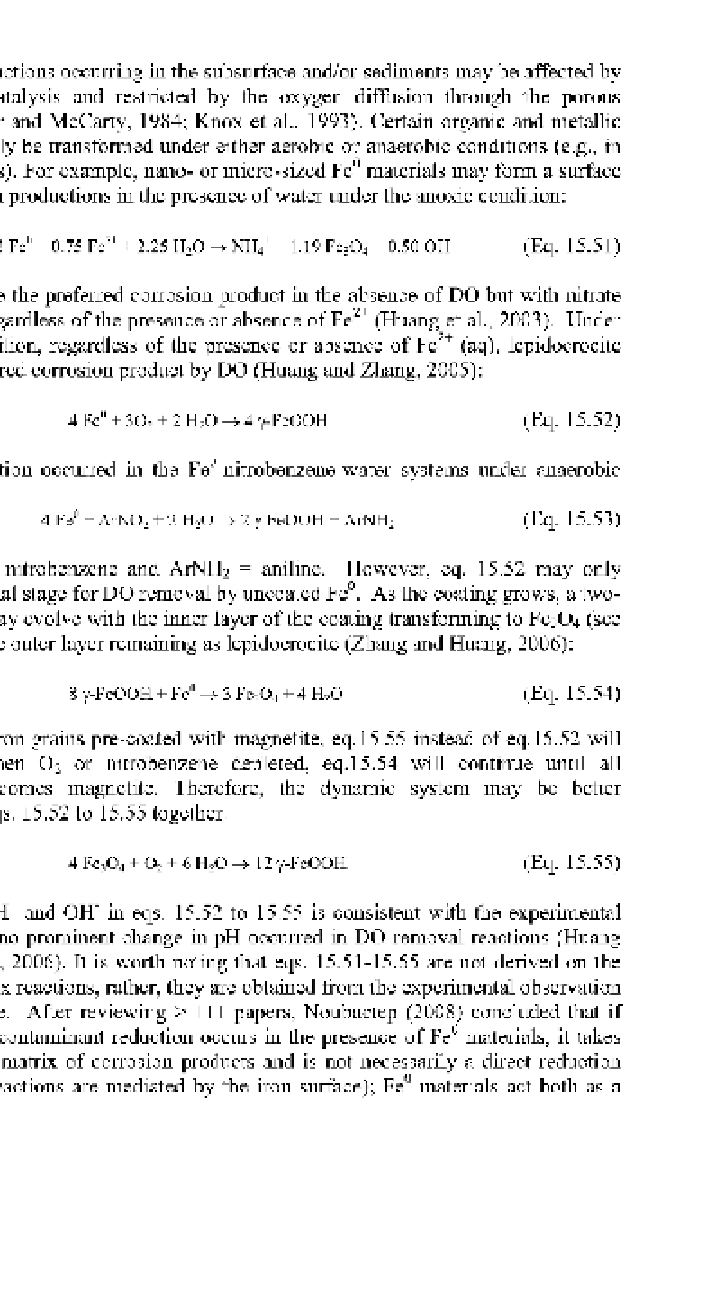Environmental Engineering Reference
In-Depth Information
Redox reactions occurring in the subsurface and/or sediments may be affected by
heterogeneous catalysis and restricted by the oxygen diffusion through the porous
medium (Bouwer and McCarty, 1984; Knox et al., 1993). Certain organic and metallic
NMs may possibly be transformed under either aerobic or anaerobic conditions (e.g., in
aquatic sediments). For example, nano- or micro-sized Fe° materials may form a surface
layer of corrosion productions in the presence of water under the anoxic condition:
NO
3
" + 2.82 Fe° + 0.75 Fe
2
+
+ 2.25 H
2
O -> NH
4
+
+ 1.19 Fe
3
O
4
+ 0.50 Off
(Eq. 15.51)
Magnetite will be the preferred corrosion product in the absence of DO but with nitrate
being present, regardless of the presence or absence of Fe
+
(Huang et al., 2003). Under
the aerobic condition, regardless of the presence or absence of Fe
+
(aq), lepidocrocite
will be the preferred corrosion product by DO (Huang and Zhang, 2005):
4 Fe° + 3O
2
+ 2 H
2
O -> 4 y-FeOOH
(Eq. 15.52)
The similar reaction occurred in the Fe°-nitrobenzene-water systems under anaerobic
4 Fe° + ArNO
2
+ 2 H
2
O -> 2 y-FeOOH + ArNH
2
(Eq. 15.53)
where ArNO2 = nitrobenzene and ArNH2 = aniline. However, eq. 15.52 may only
represent the initial stage for DO removal by uncoated Fe°. As the coating grows, a two-
layer structure may evolve with the inner layer of the coating transforming to Fe3O4 (see
eq. 15.54) and the outer layer remaining as lepidocrocite (Zhang and Huang, 2006):
8 y-FeOOH + Fe° -> 3 Fe
3
O
4
+ 4 H
2
O (Eq. 15.54)
In the test with iron grains pre-coated with magnetite, eq.15.55 instead of eq.15.52 will
be initiated. When ©2 or nitrobenzene depleted, eq.15.54 will continue until all
lepidocrocite becomes magnetite. Therefore, the dynamic system may be better
represented by eqs. 15.52 to 15.55 together.
4 Fe
3
O
4
+ O
2
+ 6 H
2
O -> 12 y-FeOOH
(Eq. 15.5 5)
The absence of H and OH" in eqs. 15.52 to 15.55 is consistent with the experimental
observation that no prominent change in pH occurred in DO removal reactions (Huang
and Zhang, 2005, 2006). It is worth noting that eqs. 15.51-15.55 are not derived on the
basis of half redox reactions, rather, they are obtained from the experimental observation
and mass balance. After reviewing > 111 papers, Noubactep (2008) concluded that if
any quantitative contaminant reduction occurs in the presence of Fe° materials, it takes
place within the matrix of corrosion products and is not necessarily a direct reduction
(i.e., reduction reactions are mediated by the iron surface); Fe° materials act both as a

Search WWH ::

Custom Search